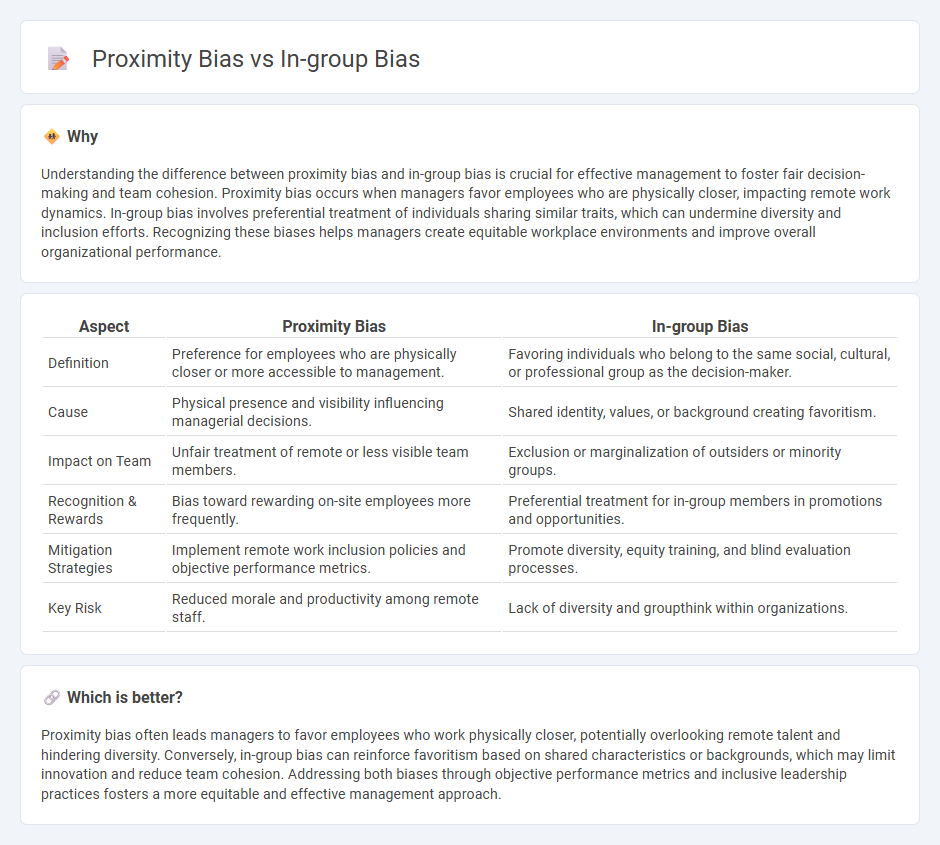
Proximity bias occurs when managers favor employees who are physically closer, impacting remote team dynamics and performance evaluations. In-group bias refers to the preference for individuals who share similar characteristics, backgrounds, or affiliations, influencing hiring and promotion decisions. Explore how understanding these biases can improve organizational fairness and productivity.
Why it is important
Understanding the difference between proximity bias and in-group bias is crucial for effective management to foster fair decision-making and team cohesion. Proximity bias occurs when managers favor employees who are physically closer, impacting remote work dynamics. In-group bias involves preferential treatment of individuals sharing similar traits, which can undermine diversity and inclusion efforts. Recognizing these biases helps managers create equitable workplace environments and improve overall organizational performance.
Comparison Table
| Aspect | Proximity Bias | In-group Bias |
|---|---|---|
| Definition | Preference for employees who are physically closer or more accessible to management. | Favoring individuals who belong to the same social, cultural, or professional group as the decision-maker. |
| Cause | Physical presence and visibility influencing managerial decisions. | Shared identity, values, or background creating favoritism. |
| Impact on Team | Unfair treatment of remote or less visible team members. | Exclusion or marginalization of outsiders or minority groups. |
| Recognition & Rewards | Bias toward rewarding on-site employees more frequently. | Preferential treatment for in-group members in promotions and opportunities. |
| Mitigation Strategies | Implement remote work inclusion policies and objective performance metrics. | Promote diversity, equity training, and blind evaluation processes. |
| Key Risk | Reduced morale and productivity among remote staff. | Lack of diversity and groupthink within organizations. |
Which is better?
Proximity bias often leads managers to favor employees who work physically closer, potentially overlooking remote talent and hindering diversity. Conversely, in-group bias can reinforce favoritism based on shared characteristics or backgrounds, which may limit innovation and reduce team cohesion. Addressing both biases through objective performance metrics and inclusive leadership practices fosters a more equitable and effective management approach.
Connection
Proximity bias and In-group bias are connected through their influence on managerial decision-making and team dynamics, where managers tend to favor employees who are physically closer or share similar characteristics, leading to unequal opportunities and reduced diversity. These biases reinforce each other by creating echo chambers within organizations, limiting the inclusion of diverse perspectives and hindering innovation. Addressing both biases simultaneously is essential for fostering fair management practices and promoting an equitable workplace culture.
Key Terms
Group Dynamics
In-group bias enhances group cohesion by favoring members who share similar traits, reinforcing social identity and trust within the group. Proximity bias influences group dynamics by prioritizing collaboration with physically or digitally closer members, often skewing opportunities and communication channels. Explore more about how these biases shape team performance and decision-making processes.
Workplace Diversity
In-group bias in workplace diversity leads employees to favor colleagues with shared characteristics, impacting team cohesion and decision-making. Proximity bias causes managers to prioritize employees physically nearer, often disadvantaging remote workers and reducing inclusive practices. Explore effective strategies to mitigate these biases and foster genuine workplace diversity.
Decision-Making
In-group bias influences decision-making by favoring individuals within a familiar group, often leading to partiality and reduced diversity in perspectives. Proximity bias affects choices by prioritizing those physically closer, which can skew resource allocation and collaboration opportunities. Explore deeper insights into how these biases impact organizational outcomes and strategies for mitigation.
Source and External Links
In-group favoritism | EBSCO Research Starters - In-group favoritism is a cognitive bias where people prefer and view members of their own social group more positively than those in external groups.
In-group bias - The Decision Lab - In-group bias refers to the tendency to give preferential treatment to others who belong to the same group, even when group membership is arbitrary.
What Is Ingroup Bias? | Definition & Examples - Scribbr - Ingroup bias is the tendency to favor one's own group over other groups, affecting perception and behavior towards others based on shared group identity.
 dowidth.com
dowidth.com